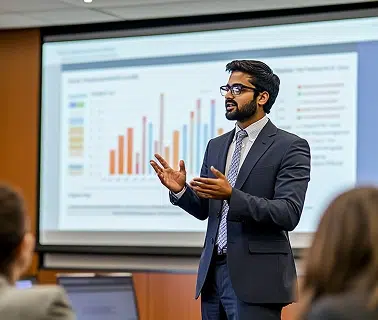You may not know this, but MBA programs are not all about only textbooks and theories – real-world applications are an important part of these courses as well. Case studies are one of the most efficient ways in which such gaps can be bridged.
These are detailed analyses of actual business challenges, and they let you see things from the perspective of decision-makers and assess strategies, outcomes, and risks. You have case studies on all types of businesses – from startups to multinational corporations.
You gain valuable insights into areas such as problem-solving, innovation, and leadership from real-world business case studies for MBA. They teach you how MBA knowledge translates into practical strategies.
Famous and Interesting MBA Case Studies
When it comes to the most famous and interesting real-world business case studies for MBA students these top the list:
1. Apple’s Comeback under Steve Jobs
Steve Jobs came back to Apple in 1997, reduced around 70% of its product lines, focused on specific core products and doubled down on design, supply chain, user experience, and innovation. He also restored confidence in the brand by launching iMac in 1998.
This shows that focus and clarity are strong tools. Apple was revived because Jobs knew what not to do and focused on fewer and better products.
Such MBA case studies with solutions show that at times cutting could be a strategic move over adding.
2. Kodak’s fall in the Digital Age
Kodak filed for Chapter 11 bankruptcy in 2012 after resisting going fully digital for years even though it developed the first digital camera back in 1975. It did so because it was afraid it would cannibalize its film business.
If you ignore technological change as a business because it will threaten your current revenue streams, it could be risky for you.
These MBA case study examples teach you to continuously monitor disruptive technologies, even when they pose a threat to your core business.
3. Pristine Furnishings: Legal Challenges and Recovery through Stricter Audits
Pristine Furnishings faced legal trouble due to faulty supplies, a bounced cheque, and a consumer injury claim. These exposed gaps in quality control, contracts, and financial practices.
The company responded with stricter audits, revised contracts, better cheque handling, and legal training turning setbacks into a structured recovery strategy.
4. Amazon’s Customer-Centric Growth Strategy
Following its inception in 1994, Amazon has grown to become the biggest e-commerce marketplace in the world from an online bookstore. Its strategy has always focused on customer obsession, including fast delivery, competitive prices, a vast selection, and consistent innovation, such as Prime and Alexa.
This demonstrates that if you put customers at the heart of it, even ignoring short-term profits, it can lead you to dominate the market in the long term.
Through these MBA case studies with solutions, you learn that a customer-focused approach, a long-term vision, and strategic infrastructure investment can offer a lasting competitive advantage.
5. Dove’s “Real Beauty” Campaign
Dove started the “Campaign for Real Beauty” in 2004, where it featured ladies with various body types, ages, and skin tones over conventional models. It sparked global conversation by challenging unrealistic beauty standards, and in three years, Dove’s sales went to USD 4 billion from USD 2.5 billion.
This way, you learn that you can transform a brand if you connect emotionally with your audience and are authentic in your marketing.
Such MBA case study examples teach you that you must follow customer values, make it emotionally meaningful, and build trust to market effectively.
6. Amul’s Cooperative Dairy Model (H3)
In 1946, Amul started as a farmer-owned cooperative in Anand, Gujarat, and now in 2025 it is the biggest dairy brand in the country, processing over 28 million litres of milk daily. It was Amul that pioneered the White Revolution of India as well.
So, when you empower stakeholders during scale building, it can drive both financial success and social benefits.
One of the most famous MBA case studies in India, Amul’s instance demonstrates that it is possible to create a social impact and achieve financial prosperity simultaneously.
7. IBM’s Shift from Hardware to Services
IBM’s traditional hardware business revenues started to go down in the 1990s and then it decided to switch to IT consulting and services. The leadership of CEO Lou Gerstner played a major role in helping it revive its fortunes and become an enterprise solutions leader.
This shows that you need to make bold strategic shifts if you want to revive a legacy brand. Diversification and adapting to market requirements can help companies avoid obsolescence.
These MBA case studies topics demonstrate that companies must be agile in recognizing declining markets and respond quickly.
Check This Out: Career prospects after an MBA in Healthcare Management
8. Pepsi vs. Coca-Cola Ad Wars
Pepsi and Coca-Cola have been embroiled in some of the most intense marketing battles for ages especially between the 1970s and the 1990s. Pepsi targeted the young generation while Coca-Cola depended on heritage and tradition. Both brands have competed aggressively for their share of the global market.
Thus, emotional appeal and brand positioning are the most critical factors in immensely competitive markets. Consumer preferences can be redefined by such ad wars.
Brand storytelling and differentiation become more important in saturated markets than product features.
9. Nokia’s Missed Smartphone Opportunity
Nokia used to dominate the mobile phone market in the early 2000s but failed to adapt to the smartphone revolution that Android and Apple brought about. It depended too much on Symbian OS and was slow to innovate which led to its steep decline that ended with the sale of its phone division to Microsoft.
This is proof that market leaders too can fall quickly if they do not flow with disruptive innovation. As Nokia lagged in software development it proved to be its end.
You always have to anticipate technological shifts. If you fail to adapt to consumer preferences and innovate, you will be erased despite a dominant position.
10. Flipkart vs. Amazon India Battle
From its beginning in 2007 till 2013 Flipkart was the e-commerce innovator of India when Amazon entered. Both of them used deep discounts, customer-centric features, and logistics innovation to combat each other. This ended in 2018 with Walmart backing Flipkart.
This demonstrates that local companies can thrive against global giants if they leverage cultural understanding, regional adaptability, and customer trust.
When you are competing in an emerging market you must use agility, deep localization, and partnerships to prosper against global brands.
11. Netflix vs. Blockbuster – The Disruption Story
Blockbuster used to dominate the video rental market but was unable to adapt to digital streaming. Netflix began business with mail-order DVDs and in the late 2000s pivoted to streaming, which disrupted the entire industry. By 2010, Netflix became globally dominant while Blockbuster filed for bankruptcy.
The key lesson here is that embracing technology is perhaps the only way to future proof your business. If you resist changes you will be destroyed.
You must be agile with your business model and adapt quickly to customer behavior and technological shifts.
12. Google’s “20% Time” Innovation Culture
Google became the first company to let its employees spend 20% of their working time on personal innovative projects. This helped create the likes of Gmail, AdSense, and Google Maps.
So, if you empower employees with creative freedom, it can lead to groundbreaking innovations.
Corporate culture drives innovation, and companies can unlock long-term growth with intrapreneurship.
13. Vistaar LearnTech: Resetting People Priorities Through Upskilling
Vistaar LearnTech scaled rapidly but faced chaos marked by unclear roles, burnout, and high attrition. A new HR strategy introduced structured hiring, clear roles, targeted upskilling, OKR-based reviews, transparent grievance handling, pay rationalisation, and well-being measures.
Within a year, attrition dropped, productivity rose, and Vistaar became a top startup to work for showing how structured, empathetic HR can sustain fast growth.
14. Aryavarta: Reviving Through HR Transformation
Aryavarta Textiles faced attrition, unclear roles, and low productivity due to weak HR systems. By introducing structured recruitment, training, appraisals, and welfare measures, the company improved skills, compliance, and culture.
Within a year, attrition fell, productivity rose, and morale strengthened proving the power of strategic HR reform.
You Might Also Like: MBA in Finance vs. MBA in FinTech
15. Zomato’s Business Model Evolution
Zomato started off as a restaurant delivery platform in India but grew to offer food delivery and cloud kitchen services, and expanded outside the country too. Despite facing profitability issues and stiff competition, it went public in 2021.
This shows that businesses can survive competitive markets if they diversify and are adaptable.
One of the most famous MBA case studies in India, this teaches you to always change your business model depending on customer demands and market shifts.
16. Coca-Cola’s New Coke Failure and Product Revival
Coca-Cola changed its original formula in 1985 and came out with New Coke so that it could compete with the sweeter taste of Pepsi. This move backfired and led to consumer backlash. It reintroduced Coca-Cola Classic and regained loyalty.
The crux of the matter is that if you mess with your brand identity it could alienate your loyal customers. So, it is crucial to heed customer feedback.
Brand loyalty is a strong tool that needs protection. Changes have to align with customer perceptions and emotions.
17. Uber’s Business Model and Regulatory Battles
Uber revolutionized urban transport thanks to its ride-hailing model but experienced backlash worldwide because of regulatory issues, ethical practices, and driver treatment. Despite these challenges, it still remains a global mobility leader.
This teaches us that disruptive models always face regulatory issues and so businesses must balance innovation and compliance.
If you want to scale disruptive businesses you will need to be farsighted in legal, regulatory, and ethical frameworks.
18. Nike’s “Just Do It” – Brand Building with Athletes
Nike launched the Just Do It campaign in 1988 and it was endorsed by athletes of the caliber of Michael Jordan. This made it a symbol of performance and empowerment. Nike’s sales skyrocketed and it secured global dominance.
The major lesson here is that you can create timeless value by tying emotional branding with cultural icons.
You can establish long-lasting and robust brand equity through athlete partnerships and effective slogans.
19. Boeing 737 Max Crisis
Boeing’s 737 Max suffered a couple of crashes – one each in 2018 and 2019 – and they laid bare the flaws in its safety oversight and MCAS software. Boeing grounded its fleet worldwide which led to severe reputational damage and billions in losses.
This is the most prominent proof of the fact that if you rush products without prioritizing safety it can have catastrophic consequences.
Engineering excellence has to be allied with a safety-first culture and ethical responsibility.
20. Tata Nano – Failure of a People’s Car
Tata Nano was launched as the cheapest car in the world in 2009 and positioned as the people’s car. However, bad marketing, affordability-related stigma, and safety concerns contributed to its failure. Tata stopped producing the Nano in 2018.
The important thing to learn from this example is that only a low price does not guarantee success – perception, branding, and safety are more important.
Customer perception and marketing strategy are equally crucial as pricing innovation.
21. Volkswagen Emissions Scandal
In 2015 Volkswagen got exposed for using software to cheat in emission tests and it had done so in millions of vehicles. As a result of the scandal, it had to pay billions in fines, there were plenty of resignations, and its reputation took a huge hit.
Evidently, compliance and ethics are crucial in business. If you try to gain in the short term using unethical practices it can destroy your brand’s long-term trust.
Business strategy must be guided by ethical leadership and corporate governance for sustainability.
22. GlobaTech: Bridging Cultures Through Communication Styles
GlobaTech India faced communication gaps with a Japanese client due to cultural differences, causing delays and frustration.
Cross-cultural training, etiquette protocols, bilingual coordination, and clear communication frameworks improved collaboration, trust, and delivery, showing that cultural awareness is key to global teamwork.
23. Starbucks’ Experience-Based Branding
Starbucks caused a significant shift in the coffee industry by emphasizing customer experience, including cozy cafes, a community culture, and personalized service. This differentiated it from other brands that were only selling coffee – it became synonymous with lifestyle.
This teaches us that there is more to branding than only products – it is about emotional connections and experiences.
Customer experience can be just as valuable as the product. So, companies need to invest in lifestyle positioning and brand storytelling.
24. Tesla’s Electric Revolution and Scaling Challenges
Tesla evolved to become a major disruptor in the auto industry from being a niche maker of luxury electric vehicles (EVs). It led innovations in battery strategy, over-the-air software updates, direct-to-consumer sales, and vertically integrated manufacturing. However, it faced several challenges in scaling like manufacturing bottlenecks and quality control issues.
By itself, innovation is not sufficient – you need to be scalable as well. Moving to the mass market from boutique or craft production needs compact coordination in operations, quality, and supply.
Such MBA case studies topics teach you to think of operational scale instead of only product quality.
25. Arya Wellness: Strategic Scaling Through Demand Forecasting
Arya Wellness, a Bengaluru health beverage start-up, addressed rising demand by using ARIMA-based forecasting, optimising production layouts, and planning a new facility. Location analysis led to establishing a scalable plant in Hosur, Tamil Nadu, balancing cost, logistics, and sustainability.
These steps improved efficiency, ensured timely deliveries, and positioned the company for sustainable growth.
Also Read: 18 Top Jobs after an MBA Program
How MBA Students Can Benefit from Case Studies
The most significant benefit that you get from case studies is the opportunity to apply your theoretical knowledge to complex and real-world business scenarios. This helps you develop critical thinking, strategic decision-making, and problem-solving skills in dynamic environments.
Following in a nutshell are the most significant benefits that you can gain from case studies:
| Broader Area | Specific Factors |
|---|---|
| Skill Development | Reasoning and Critical Thinking Problem-Solving Strategic Decision-MakingEmpathy and Leadership |
| Practical Application | Bridging Practice and Theory Comprehending Business Dynamics Navigating Uncertainty |
| Professional and Personal Growth | Open-MindednessConfidence Career Exploration Communication and Teamwork |
Read More: 15 Best Courses after an MBA Degree
Conclusion
MBA case studies are not mere academic exercises – they are powerful tools that help you bridge the gap between practice and theory. When you analyze real-world business failures and successes, you gain a deeper understanding of different aspects of business administration, such as strategy, finance, leadership, innovation, and marketing.
Studying your MBA in a leading university like Manipal Academy of Higher Education, Manipal University Jaipur, and Sikkim Manipal University helps you come across the best and most prominent case studies in the world.
Sharpen your management skills by joining one of these universities and studying from the finest MBA case studies.
An Interesting Read: Top online MBA programs for working professionals
FAQs (H2)
1. What are MBA case studies, and why are they important?
MBA case studies are detailed analyses of hypothetical or real-world business problems that teach students the application of theoretical knowledge in practical situations. This improves their problem-solving, decision-making, and strategic-thinking skills.
2. How do case studies bridge theory with real-world business practice?
Case studies bridge theory and practice by letting students apply abstract business concepts to tangible and complex real-world scenarios. This cultivates their critical thinking, analytical, and problem-solving skills.
3. Which are the most popular MBA case studies taught in business schools?
The most classic examples of MBA case studies are Mumbai dabbawalas for operations, Toyota’s JIT system for manufacturing, and Hertz Global Holdings for finance.
4. What skills can MBA students develop from analyzing case studies?
By analyzing case studies MBA students develop crucial skills like critical thinking, problem-solving, analytical skills, and strategic decision-making.
5. How do case studies help in preparing for leadership roles?
Case studies prepare you for leadership roles by simulating real-world challenges and letting you practice critical thinking, ethical considerations, strategic decision-making, and problem-solving in low-pressure environments.
6. Are case studies based only on success stories or failures as well?
No, case studies do not focus on success stories only – they also include failures so that you can analyze both and get a detailed understanding of addressing challenges and implementing strategies.
Become future-ready with our online MBA program










